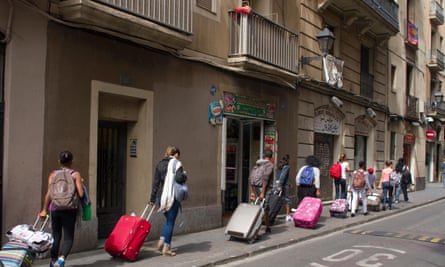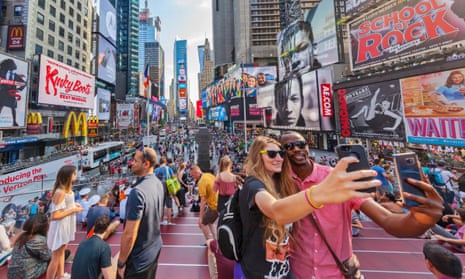The resurgence of rail
First the Scandinavians gave us hygge, then they gave us flygskam (flight shame), which has nothing to do with candles and everything to do with guilt about the environmental cost of flying.
The Guardian’s product and service reviews are independent and are in no way influenced by any advertiser or commercial initiative. We will earn a commission from the retailer if you buy something through an affiliate link. Learn more.
If the noughties were all about a giddy sense of the world opening up thanks to the rise of low-cost flights and online booking tools, the subsequent decade has started to feel like payback time, as we begin to reckon with the cost of our globetrotting ways. A 2019 YouGov report showed levels of concern about the environment at a record high. As the climate change crisis becomes more acute and the cost of overtourism bleakly apparent from Venice to Machu Picchu, there’s a growing sense that we need to rethink not just where we travel but how we travel, too.
Tour operators that offer rail-based holidays are reporting record enquiries. Ffestiniog Travel, which specialises in tailormade and escorted rail tours, has seen a 30% increase in bookings since 2017. And after years of declining sales, the Interrail pass – that rite of passage for generations of young travellers – has started to see a turnaround, with sales of 300,000 in 2018, almost three times the figure for 2005.
After years of cuts to European sleeper services, there are signs that the tide may be beginning to turn here, too. Next month, a new Nightjet service will launch between Vienna and Brussels, while Swiss Federal Railways is also looking into reintroducing its Wagon-Lits overnight services after they were cancelled in 2009. Sleeper trains from Amsterdam to other European capitals could also be in the offing.
Could this be the start of a new golden era of rail travel? It’s too soon to say, but there are signs that our love affair with low-cost flying is cooling. And when you smugly book a rail trip and feel a sudden urge to tell your friends, remember the Swedes have a word for that too – tagskryt (train bragging).
Peer-to-peer travel

It’s estimated that, on any given night, 2 million people are staying in an Airbnb rental. But 10 years ago Airbnb was just another San Francisco start-up looking for investors. The three founders had come up with the idea to make some extra cash by renting out an airbed on their living room floor.
The idea quickly inflated to become a global travel empire that today has more than 7 million listings in 191 countries. The company’s slogan, “Belong Anywhere”, tapped into a desire for a more authentic and intimate experience than traditional hotels could offer. You could hang out with your host, get insider tips on bars and restaurants, and shop at the neighbourhood deli like a local.
In 2016, Airbnb further capitalised on this wish to go beyond the tourist traps by launching its own range of “Experiences” with local guides, offering everything from bar crawls in Barcelona to pasta-making lessons with Italian grandmas.
The success of Airbnb has inspired dozens of imitators, with peer-to-peer equivalents for every travel need, whether it be camping (campspace.com), yacht sharing (borrowaboat.com) or currency exchange (weswap.com).
Inevitably, with such rapid growth came some snags: stories of dodgy hosts, dodgy guests, inferior accommodation, last-minute cancellations and fake reviews. There has also been growing unease about the impact Airbnb has had on rents in cities such as Barcelona, with landlords able to make more money from short-term guests than long-term rentals.
But despite critics’ complaints that Airbnb is changing the nature of the very neighbourhoods it aims to celebrate, there are no signs that the bubble is about to burst. The company, now valued at more than $35bn, recently acquired a hotel booking system and app and a luxury holiday rental company, and has announced that it’s about to start selling adventure holidays, too. It’s a long way from a blow-up mattress.
#Hashtag holidays

One of the most popular “experiences” Airbnb sells is the “Instagram photo walk”, where a local influencer or photographer will snap tourists in front of various landmarks and offer tips on how to capture the perfect social media shots. That such tours exist is testament to the power of the photo-sharing platform, which launched in 2010, ushering in a decade of bad selfies and Insta-sunsets.
In a recent WeSwap survey of 2,000 18-34-year-olds, 37% of respondents said their choice of holiday destination was influenced by social media, and 31% said that posting holiday snaps online was just as important as the holiday itself.
While it’s true that a picture can be worth a thousand words, it can also inspire tens of thousands of Instagrammers to try to capture the exact same image. Tales abound of bloggers queuing along the narrow cobbled streets of Santorini to replicate an iconic shot of Oia’s blue-domed church, and brawling at Rome’s Trevi fountain as tourists jostle for the perfect selfie.
As well as influencing our choice of destination, the rise of image-sharing platforms has started to have an impact on the way those destinations look. Hotel designers are now briefed to include Insta-friendly features, whether it be an eye-catching mural or a hot tub with a view. Cavo Tagoo, a luxury boutique hotel on Mykonos, Greece, is an example of what happens when that’s done well. Its infinity pool with colour-changing lights, aquarium bar, minimalist white decor and sunset views is irresistibly photogenic and has helped it to become the most followed hotel on Instagram this year.
Camping to glamping

According to Google Trends, the word glamping first appeared as a search term in 2007, but the trend for posh camping really took off in the past decade. By 2016 it had earned an entry in the Oxford English Dictionary.
The first glampsites comprised a smattering of tipis or yurts in a field – essentially, camping holidays for people who didn’t want to put up their own tents – but intensifying competition has upped the ante. In recent years anything from retired ambulances to old shipping containers have been pressed into service, and the quest for novelty reached new heights, literally, in 2017, when glamping specialist Canopy and Stars suspended a cabin from a cargo crane above Bristol harbour.
The company, which launched in 2010 and now offers 700 places to stay, says it has seen a 30% increase in bookings for next year, with treehouses the most popular option.
The trend is showing no signs of slowing down, as more of us look to switch off from digital devices and reconnect to nature, if only for a weekend. Research carried out by Pinterest on the most popular search terms this year showed that one of the biggest leaps was for “bushcraft camping”, which jumped by more than 1000% year on year.
The wellness revolution

Earlier this year, the legendary Ibiza party hotel Pikes – whose swimming pool was the backdrop for Wham’s Club Tropicana video back in 1983 – announced that it would be running its first spring fitness retreat, the three-night Rockovery, in May. It was a seminal moment – proof that “wellness” had indeed become the new rock’n’roll.
The island’s decision to reinvent itself as a holistic holiday destination was a shrewd one. Wellness tourism is big business, and growing faster than any other sector of the travel industry. Once the preserve of dedicated health resorts and retreats, it has gone mainstream, from fitness bootcamps in the Algarve to mindful skiing in the Alps.
Perhaps one of the biggest shifts has been “wellness” moving out of the hotel basement and into the great outdoors. Where once a spa break meant shuffling in white towelling slippers between hot tub, sauna and massage table, now it’s all about reconnecting with nature and enjoying mindful exercise. Forest bathing, stargazing and wood-fired hot tubs are replacing gyms and infinity pools as selling points.
The Finn Lough resort near Enniskillen in County Fermanagh is a good example of the new breed of low-key holistic retreats: here guests follow a trail through the grounds, stopping off at a lakeside hot tub, an aromatherapy sauna or a woodland shower.
The desire to escape our sedentary, switched-on lives is also driving the growth of fitness and wellbeing festivals, such as the Big Retreat in Pembrokeshire, which, as well as yoga, Pilates and circuit training, offers cookery classes, tai chi and wild swimming.
With Google Trends reporting that searches for “wellness retreats” have increased by 182%, this isn’t a fad that’s going away any time soon.
Experiential holidays

Experiences are the new luxury. Rather than splashing their cash on designer goods, people with disposable income are choosing to spend it on “transformational experiences”.
Whether it’s learning to cook with immigrants from Asia, Europe and South America in their New York City homes or joining a reforestation programme in the Amazon, travellers are looking for more meaningful interactions with locals and for immersive experiences that go beyond ticking off the usual sightseeing spots.
Tour operators are catching on to the trend. Scott Dunn recently launched its own “experiential” portfolio, offering a range of personalised activities, from perfume-making workshops in Paris to taiko drumming lessons in Tokyo.
Hoteliers are also starting to respond to these consumer shifts. It’s no longer enough to offer a comfortable bed, a decent breakfast and an eye-catching design; the new breed of “lifestyle” hotels are courting their guests with the promise of immersion into a neighbourhood, a chance to mingle with locals and a menu of enriching activities.
The Whitworth Locke, which opened last year in a former cotton mill near Manchester’s Canal Street, is a perfect example of this new hybrid of accommodation and culture hub. Before guests have even picked up their room key, they’re plunged into a world of exciting possibilities. Free yoga class? Painting workshop? Browsing the homewares and houseplants for sale in the lobby? Dining on Mexican street food in the pop-up restaurant?
With a new emphasis on informality and authenticity, it appears that traditional tourism providers, be they hotel chains or tour operators, are finally starting to learn from the successes of their peer-to-peer rivals and, in doing so, creating a new template for tourism.
If they’re going to survive the next decade, it’s a lesson they’ll need to score full marks in.
Looking for a holiday with a difference? Browse Guardian Holidays to see a range of fantastic trips
